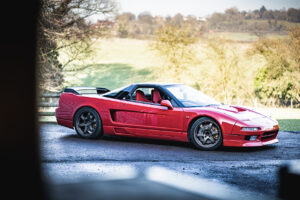Never meet your heroes. Or, in the case of this Honda NSX, meet your heroes, then make them better.
The European old guard of sports car making had arguably got a little complacent when the Honda NSX arrived in 1990. Much that came out of British and Italian factories was brilliantly stylish, but often cumbersome, poorly-built and underwhelming to drive. These cars were able to succeed on the reputation of their badge alone – which is how we ended up with the likes of the disappointingly naff Ferrari Mondial.
The Porsche 911 was the closest thing around to a properly usable, robust sports car, but it lacked the pointy, wedgy styling that was in vogue at the time, and its high-speed handling wasn’t exactly friendly for the inexperienced.
Enter Honda, and a car that arguably changed the sports car landscape forever. The NSX – ‘New Sportscar Experimental’ – had the look; a striking, cab-forward profile and pop-up headlights saw to that. It had the performance, too, thanks to a 3.0-litre V6, equipped with the company’s then-new VTEC system and 270bhp. The much-acclaimed handling was informed to some extent by Ayrton Senna’s feedback following a thrash around Suzuka in a development car.
And yet, it was comfy, quiet and refined, and built to Honda’s always-high standards. There were no low-speed manoeuvring histrionics, visibility was excellent, and when it needed servicing, you could pop it down to your local Honda dealership like it was a 1.6 Civic.
It’s no wonder it’s been lauded since as the definitive ‘everyday supercar’. For some, in fact, it was arguably too ‘everyday’, those edgy, wedgy looks writing cheques that its relatively cosseting driving experience couldn’t cash.
Filmmaker Al Clark was in this camp. Growing up in the 1990s, in the golden age of Japanese performance cars, he’d fallen hard for the NSX’s looks and giant-slaying capabilities while watching Best Motoring track battles and touge videos.
Fast forward to the early 2010s, and Al was looking for a replacement for a Porsche 996 Turbo. He stumbled upon a stock, original NSX in yellow, for sale for a now-unimaginable £22k. He made his way to London for a test drive which, at 30mph on suburban roads, he describes as “a catastrophic disappointment.”
He left it alone, but an encounter at the Nürburgring a few years later with a modified, high-mileage example made everything click into place – what had felt sluggish and underwhelming in London was suddenly, in Al’s words, “the best handling car [he’d] driven.”
A week later, this red example had found its way into his garage, despite prices more or less doubling since his test drive in the yellow car.
It was a special car he tracked down too, a sort of greatest hits compilation of the original NSX’s variants. Much of it comes from 1992’s hardcore, ultra-rare Japan-only NSX-R, which donates a carbon bonnet and B-pillars, underbracing, gauge cluster and lightweight red carpets.
Though this is an earlier NA1 car, with the period-correct pop-up headlights, the rear bumper is the bigger, chunkier unit from the facelifted NA2, complete with carbon crash bars.
Power is up to 305bhp via a few tweaks including a carbon airbox, and a short-ratio gearbox helps transmit the extra power. Adding some extra ’90s punch to the looks are a pair of red cloth Recaro buckets and a grey, custom-order set of the quite frankly legendary Volk TE37 wheels.
Al mainly uses the NSX as a road car, but it has a couple of hillclimb entries under its belt where, true to form, it’s bothered the times of cars well above its pay grade. We’ll leave it to him to sum up the ownership experience: “It’s real-world fast, reliable, easy to live with, good on fuel, great to look at and rare enough that it’s still exciting to see another one. 10/10, would recommend to a friend.”












